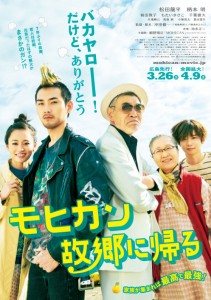JQ Magazine: Manga Review — ‘Kitaro and the Great Tanuki War’

“The Great Tanuki War stands apart from the other Kitaro volumes because in this adventure, the stakes are higher than anything you’ve ever seen.” (Drawn and Quarterly)
By Julio Perez Jr. (Kyoto-shi, 2011-13) for JQ magazine. A bibliophile, writer, translator, and graduate from Columbia University, Julio currently keeps the lights on by working at JTB USA while writing freelance in New York. Follow his enthusiasm for Japan, literature, and comic books on his blog and Twitter @brittlejules.
A haunted house built on an ancient burial ground? That’s minor league. How about an entire nation built above an army of human-hating yokai who command a catfish large enough to cause earthquakes?
Shigeru Mizuki’s Kitaro and The Great Tanuki War is a manga volume that tells an epic tale pitting the titular character, Kitaro, against an army of tanuki and their powerful yokai allies. There are also a few bonus stories with Kitaro’s usual one-shot adventures. You may already be familiar with Mizuki’s famous character, but if you are not, you can brush up on his origin story featured in the first volume, The Birth of Kitaro, which JQ reviewed last year here.
This marks the third volume in the English collection of Kitaro stories published by the fine folks at Drawn and Quarterly. One of our very own JET alums, Zack Davisson (Nara-ken, 2001-04; Osaka-shi, 2004-06), has been doing his part to put Shigeru Mizuki’s timeless work on the map in the English-speaking world. He has served as translator for these Kitaro stories and also for Mizuki’s colossal four-volume manga history of the Showa period. Zack is a yokai expert in his own right and you can find out more about his career and JET experience in our vintage JQ interview with him.
As many consumers of Japanese media may already be aware, yokai are strange creatures or phenomena that originate in Japan and have become widely popular globally. Kitaro is a unique yokai who solves mysteries and fights for humans. The conflict between humans and yokai is often an issue of tension for him as he straddles both sides, but this conflict takes center stage in The Great Tanuki War, when an army of tanuki escape from their underground dwelling beneath the island of Shikoku (shout-out to our Shikoku JET alums!), to wage a war on the human residents of Japan.
JQ Magazine: Film Review — JAPAN CUTS 2017 at Japan Society

Neko Atsume House, starring Atsushi Ito and an army of kitties, makes its East Coast premiere at Japan Society July 16.
(Neko Atsume House © 2017 Hit-Point:Neko Atsume House Production Committee
By Lyle Sylvander (Yokohama-shi, 2001-02) for JQ magazine. Lyle has completed a master’s program at the School of International and Public Affairs at Columbia University and has been writing for the JET Alumni Association of New York since 2004. He is also the goalkeeper for FC Japan, a New York City-based soccer team.
The 11th edition of JAPAN CUTS, the Japan Society of New York’s extensive showcase of new Japanese cinema, premieres tomorrow (July 13) for 11 days of unique programming, special guests, and the chance to see exclusive North American releases. This year’s lineup—29 films in all—demonstrates the wide variety of Japan’s contemporary cinematic space. The programming runs the gamut from documentaries to shoestring independents, old classics and mainstream blockbusters. A handful of films were made available for JQ press screenings; here are some notable selections:
Neko Atsume House (July 16, 12:00 p.m.): Based on a popular smartphone game, this film deals with writer’s block in a most unique way. When the novelist-protagonist Sakumoto-san (Atsushi Ito) finds himself faced with his profession’s most dreaded dilemma, he accepts an assignment to write a series of horror novels—a major step backward for this once-celebrated author. In order to solve his predicament, he adopts the old cliché of secluding himself in a country house for creative inspiration. What follows is a thoroughly unexpected delight of a movie as he makes friends with a multitude of friendly felines with whom he bonds.
At the Terrace (July 16, 6:45 p.m.): Kenji Yamauchi adapts his play for the screen, in what can best be described as a Japanese Who’s Afraid of Virginia Woolf? This dialogue-heavy film finds a group of guests drinking into the night. As the alcohol makes its way through their systems, the characters let down their guard and inhibitions and make confrontational and incriminating accusations against one another. The veneer of civility gradually dissipates until the carnal desires and petty jealousies take over the proceedings. In the process, Yamauchi skewers the pretensions of Japan’s professional and bourgeois class.
Haruneko (July 16, 8:45 p.m.): Dealing with the Japanese fascination with death is first-time director Soro Hakimoto’s Haruneko, a tale set at a forest café where people come to die. In some ways, the setting reminds one of the infamous “suicide forest” at the base of Mt. Fuji, another place for a similar purpose. Unlike that real location, Hakimoto creates an ambience that can only be described as “melancholy mysticism” as the café manager, young boy and an old woman guide their visitors into the deep woods to dissolve into the ether. This film debut serves as a harbinger of great things to come from Hakimoto, who establishes himself as Japan’s answer to the great Thai director Apichatpong Weerasethakul (Tropical Malady, Uncle Boonmee Who Can Recall his Past Lives).
JQ Magazine: Book Review — ‘25 Places in Canada Every Family Should Visit’

“This year marks Canada’s 150th anniversary, so it’s a wonderful time for families to explore the wonders of the country. You just need the right information to do so, and 25 Places serves as a worthy reference guide.” (TouchWood Editions)
By Rashaad Jorden (Yamagata–ken, 2008-10) for JQ magazine. A former head of the JETAA Philadelphia Sub–Chapter, Rashaad is a graduate of Leeds Beckett University with a master’s degree in responsible tourism management. For more on his life abroad and enthusiasm for taiko drumming, visit his blog at www.gettingpounded.wordpress.com.
Summer is almost here. With the kids out of school, it’s the perfect time to explore new places and travel as a family. But where should you go?
Those thinking about Canada should seek out Jody Robbins’ 25 Places in Canada Every Family Should Visit for ideas. Robbins, a JET alum (Tottori-ken, 1994-97) and arguably one of Canada’s most prominent travel writers, profiles locations going counterclockwise from Victoria to Yukon, from the famous (Toronto, Vancouver) to the relatively unknown (Parksville-Qualicum Beach, Avalon Peninsula).
As the book is geared towards parents, Robbins devotes plenty of space to sharing advice about how they can entertain their young ones. In addition to expounding on the requisite what to do and see activities for each destination, Robbins just as importantly lists family-friendly options for dining (“Kids will love the wood-fired bambino pizza” at Pizzeria Prima Strada in Victoria) and lodging (a highlight of the Fairmount Chateau Laurier in Ottawa is the Art Deco-style pool, which “children love parading down to in their child-size bathrobes”).
25 Places features a diverse mix of urban and nature-filled destinations (like Outaouauis), so readers will get a great sense of Canada’s varied landscapes, as well as some surprises (beaches on the Prairies? Yes, they exist) and more importantly, how to arrive prepared for them. While it’s obvious that Robbins would include information about how to get around certain places, she excels when extensively detailing how to make your camping trip a safe and wonderful experience: An entire chapter is devoted to providing readers advice about tackling and overcoming the challenges that awaits (as well as tips about what to pack and eat). Camping novices would do well to heed this helpful advice.
JQ Magazine: Book Review — ‘The Little Exile’
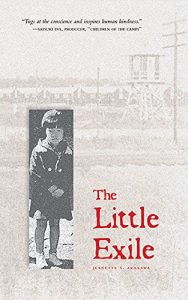
“The Little Exile reveals a world of angst, but hope in a world that has been turned upside down.” (Stone Bridge Press)
By Rashaad Jorden (Yamagata-ken, 2008-10) for JQ magazine. A former head of the JETAA Philadelphia Sub-Chapter, Rashaad is a graduate of Leeds Beckett University with a master’s degree in responsible tourism management. For more on his life abroad and enthusiasm for taiko drumming, visit his blog at www.gettingpounded.wordpress.com.
Earlier this year I explored Uprooted, an exhibition devoted to the Japanese American internment. Considering how many families were displaced following Pearl Harbor, “uprooted” is at the perfect word to describe how a lot of people’s lives were disrupted.
Uprooted also comes to mind when reading The Little Exile. Written by Jeanette Arakawa, the novel tells the story of Marie Mitsui, a Japanese American girl living in San Francisco, whose world is jolted after the events of December 7, 1941 as she and her family is forced to relocate to an internment camp in Arkansas. Based on her own life story (although some names in the book have been changed), Arakawa takes readers on a journey through the brutal challenges that many Japanese Americans faced.
At first, you might think that The Little Exile is an uneventful novel, as the first few chapters capture a seemingly carefree life that the Mitsuis enjoy (Marie has an older brother named Brian). They seem to be a typical American family—Marie’s parents run a dry cleaning shop where the whole family lives. She loves roller-skating with her friend Beverly and often spends time on the playground (She frequently wins amateur hour contests there).
However, San Francisco is not paradise for the Mitsuis—Brian learns from his father that due to “racial covenants,” the family is prohibited from buying houses in a certain neighborhood. In addition, classmates hurl racial slurs at Brian and Marie upon their arrival at the Lawton School in December 1940.
JQ Magazine: Book Review — ‘Japanese Garden Notes’
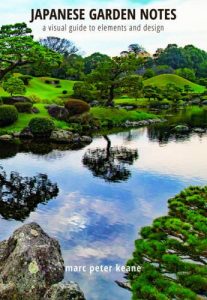
Keane is the perfect person to expound on the finer aspects of the Japanese garden. Reading Japanese Garden Notes basically transports you to a museum as the text is similar to the interpretation you’d receive from a seasoned docent. (Stone Bridge Press)
By Rashaad Jorden (Yamagata-ken, 2008-10) for JQ magazine. A former head of the JETAA Philadelphia Sub–Chapter, Rashaad is a graduate of Leeds Beckett University with a master’s degree in responsible tourism management. For more on his life abroad and enthusiasm for taiko drumming, visit his blog at www.gettingpounded.wordpress.com.
One Golden Week afternoon after exploring Okayama Castle, I decided to stroll over to nearby Kōraku-en Garden. Mainly because it was there and I wasn’t sure what else to do in Okayama. But once I stepped on the premises of the garden, a sense of serenity fell over me as did the feeling I felt like I had found a gem, as well as a place where time stood still.
What is the world of these elegant locales like? Landscape architect and author Marc Peter Keane answers that question and more in Japanese Garden Notes: A Visual Guide to Elements and Design.
It’s clear that Keane, a garden designer and Kyoto resident for roughly twenty years, will explain “what makes a Japanese garden feel the way it does” largely through photographs. But what will readers be looking at? Pretty much Japanese Gardens 101, as each chapter bears the name of a concept or feature present in Japanese gardens like meandering paths, arbor bridges, streams, and more. A phrase further describing the main concept appears prior to the explanations in each chapter and those descriptions run the gamut from the profound (“A meandering path is full of surprises”) to the explanatory regarding the appearance of the garden (“Linking a distant part of the garden with the foreground”) to the borderline hilarious (“Japan is wet, thus the dry garden.”).
JQ Magazine: Film Review — ‘Your Name’
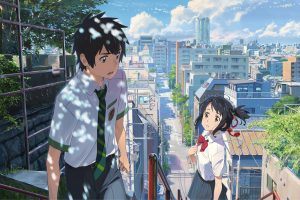
“You do not have to like animated or Japanese films specifically to love Your Name. However, it is rare for any film to capture the Japanese essence and tone as this one has so expertly achieved.” (© 2016 “YOUR NAME.” FILM PARTNERS)
By Greg Beck (Hiroshima-ken, 2006-11) for JQ magazine. Greg is a writer, producer, home brewer, and Social Coordinator for JETAA Southern California and Arizona. A former news producer for Tokyo Broadcasting System in New York, he currently works freelance in Los Angeles. For more cinema reviews, follow him on Twitter at @CIRBECK #MovieReview.
Never mind that Your Name has become the highest-grossing Japanese film internationally, anime or otherwise; this creative and beautiful film written and directed by Makoto Shinkai (5 Centimeters Per Second, Children Who Chase Lost Voices) draws on everything reverent in Japanese history and culture, celebrates the modern metropolis that is Tokyo, and tugs at your heartstrings while embracing the silly and universally relatable challenges of the human experience. You do not have to like animated or Japanese films specifically to love Your Name. However, it is rare for any film to capture the Japanese essence and tone as this one has so expertly achieved.
The story focuses on Mitsuha Miyamizu, a high school girl living in a tiny, rural village in the Hida region of Gifu—or as one classmate puts it: “the boonies.” Growing up with her little sister and grandmother at the local shrine, we are introduced to a culturally rich history of weavers who connect their trade to the local Shinto god and traditions. Mitsuha feels understandably cramped by her rural routine and dreams of moving to Tokyo. Suddenly, that is just where she finds herself, inexplicably waking up in the body of our second protagonist, Taki, a boy of the same age, living in a small apartment with his father in Shinjuku.
As the story progresses, we get to enjoy both very different worlds, but there is no denying the village’s gorgeous rural landscapes rich with nature and the intimate, cultural ceremonies that take center stage. The grandmother’s patient lessons on Mitsuha’s family history grant us special access to something sacred, like a backstage pass to Japanese culture. The last film to achieve this feeling, Okuribito (Departures), later won the Oscar for Best Foreign Language Film in 2009. Your Name is similar, but surpasses it by making the cord weaving pivotal to understanding the supernatural body swapping, blending epic adventure with sublime heartache.
JQ Magazine: Book Review — ‘Fred Korematsu Speaks Up’
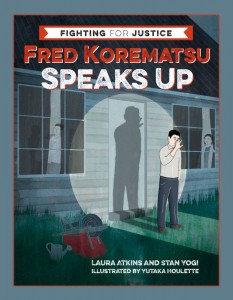
“Fred Korematsu Speaks Up skillfully introduces a civil rights icon and other brave men and women to a new audience.” (Heyday Books)
By Rashaad Jorden (Yamagata-ken, 2008-10) for JQ magazine. A former head of the JETAA Philadelphia Sub-Chapter, Rashaad is a graduate of Leeds Beckett University with a master’s degree in responsible tourism management. For more on his life abroad and enthusiasm for taiko drumming, visit his blog at www.gettingpounded.wordpress.com.
On January 30 of this year, you may have noticed a certain bespectacled figure serving as the Google Doodle: Fred Korematsu. Possibly unknown to many of you (In fact, I didn’t know the name until several days prior to his being honored by Google), Korematsu was nonetheless an important civil rights figure of the 20th century and has gotten the recognition he deserves as in recent years, with Fred Korematsu Day being celebrated in several states. Now, younger readers are offered an informative look at his fight for justice.
Co-written by Laura Atkins and Stan Yogi, Fred Korematsu Speaks Up documents the journey of the man who fought against the forced relocation of Japanese Americans to prison camps during World War II. The book provides details about Korematsu and his battle, but also about social movements and other groups that have suffered enormous discrimination, such as African Americans and Chinese Americans.
Much of Korematsu’s life story is told in poem-like stanzas, starting with an incident as a young man in which he was refused a haircut at a barbershop because of his race. Atkins and Yogi then take readers through significant moments in his life, from the personal (such as how Korematsu came to be known as “Fred”) to monumental events for the Japanese American community (like the bombing of Pearl Harbor and President Franklin D. Roosevelt signing an executive order authorizing the military’s removal of people of Japanese descent from their homes on the West Coast).
Concert Recap: Yoshiki Classical Special at Carnegie Hall
By JQ magazine editor Justin Tedaldi (CIR Kobe-shi, 2001-02). For more of his articles, click here.
On Jan. 12-13, Yoshiki of the band X Japan—the nation’s number one rock group, which has sold out the 55,000 seat Tokyo Dome a record 18 times and has moved more than 30 million singles and albums since forming in the 1980s—fulfilled a lifelong dream by debuting, and also selling out, two consecutive nights at Carnegie Hall in New York City with his Yoshiki Classical Special performance.
Backed by the Tokyo Philharmonic Orchestra conducted by Yuga Cohler with arrangements by Shelly Berg, the nearly three-hour concert brought an arena vibe to the traditional concert hall setting. Featuring a mix of X Japan classics, new material, and pitch perfect renditions from the book of Beethoven and Tchaikovsky, Yoshiki brought the tunes to life at the piano, and additional turns from guest vocalists Katie Fitzgerald and Ashley Knight provided bright spots of witty banter (unlike other Japanese superstars poised for American fame, Yoshiki’s English is fluent).
The production team pushed the limits of imagination for Carnegie Hall, with lighting so intense that Yoshiki himself had to ask his crew mid-song to reposition of one of the rigs. Videos and still images (courtesy of last year’s internationally released documentary We Are X) were amply beamed overhead throughout the show, giving the audience the full scope of Yoshiki’s lifelong artistic journey.
In the final stretch following the X Japan epic “Art of Life,” an instrumental version of “Endless Rain” spotlighted a colossal mirror ball that bathed the hall in brilliant, swirling light, as those in the front rows unexpectedly belted out its bilingual chorus to the delight of longtime fans.
While X Japan supporters might have to wait a bit longer to witness another full band performance in New York (they last headlined Madison Square Garden in 2014), Yoshiki Classical Special easily lived up to its name, making another dream come true for both performer and audience.
For additional photos and videos of the concert, visit Yoshiki’s homepage at www.yoshiki.net.
JQ Magazine: Book Review — The ‘Tonoharu’ Trilogy
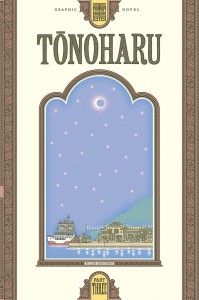
“This graphic novel series arrests your attention, from the immersive quality of the art, to the highs of self depreciating humor, to the lows of isolation and despair that run through it. Those who have lived abroad will find much to relate to.” (Top Shelf Productions)
By Julio Perez Jr. (Kyoto-shi, 2011-13) for JQ magazine. A bibliophile, writer, translator, and graduate from Columbia University, Julio currently keeps the lights on by working at JTB USA while writing freelance in New York. Follow his enthusiasm for Japan, literature, and comic books on his blog and Twitter @brittlejules.
Everyone has felt out of place at some point in their lives. People who choose to live abroad sometimes make that their everyday. In Tonoharu, cartoonist and JET alum Lars Martinson (Fukuoka-ken, 2003-2006; Kyoto-fu, 2011-2016) illustrates a story exploring themes of human relationships through the experience of an English teacher in Japan on a journey of self-discovery. Told in three parts, the final volume was released in November and represents many years of work for Martinson that began to see fruition when he received the Xeric Grant for Comic Book Self-Publishers in 2007.
Tonoharu is a tale of several non-Japanese teachers of English living in the titular rural town outside of Fukuoka City, mostly from the viewpoint of a young American named Dan Wells. Wells feels out of place in Japan, but claims to have felt the same way back home without having the excuse of being a foreigner. The reader climbs in the back seat for an intimate road trip with him through his pursuit of purpose and success in his job and social life, privy to all manner of encounters from intimacy in the bedroom to traditional parades with locally made floats. In just one year, Wells encounters unique challenges in his work, frustrations with seemingly unrequited romantic interest for another American, confusion and alarm at the mysterious activities of other foreigners in Tonoharu, and worst of all, the inability to replace light bulbs in his apartment!
Tonoharu is full of quiet moments that when described may come off as unimpressive, but they are always captivating and powerful in the way the words and imagery captures the moodiness of imperfect exchanges between people that are not usually seen in glossier fiction. This quality is enhanced by a lack of narration—the framing story of Dan’s successor (also named Dan) features his narration, but in the main story the characters only express themselves by speaking to one another. Often the things they don’t say, their expressions and their body language, and the things they choose to say while alone, speak just as powerfully as the introspective autobiographical style of narrative-driven graphic novels such as Persepolis.
JQ Magazine: Music Review — ‘Time to Play’
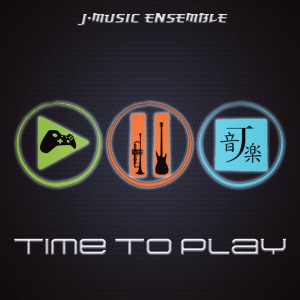
“Time to Play is a well-produced colletion of covers that delights in mixing together several genres.” (J-MUSIC Ensemble)
By Rashaad Jorden (Yamagata-ken, 2008-10) for JQ magazine. A former head of the JETAA Philadelphia Sub-Chapter, Rashaad is a graduate of Leeds Beckett University with a master’s degree in responsible tourism management. For more on his life abroad and enthusiasm for taiko drumming, visit his blog at www.gettingpounded.wordpress.com.
“J-pop meets jazz.” What does that really mean?
These words appear on the J-MUSIC Ensemble’s official website, the J-MUSIC Ensemble being a New York-based jazz-influenced instrumental band that mixes various genres. The group’s Grammy-nominated founder Patrick Bartley once told me, “We’re not just playing jazz songs; we’re taking the jazz mentality.”
So what do they serve up with Time to Play, their full-length recording debut? Befitting the group’s name, Time to Play features eight covers of songs by popular Japanese musical acts (including Hikaru Utada’s “Simple and Clean”) executed in a cohesive mix of jazz, funk, rock and pop. Sure enough, the album’s first track (and Perfume cover) “Game” features a significant rock influence with a heavy dose of bass and guitar. The album closes with another substantial touch of rock as the Yoko Kanno cover “The Real Folk Blues” also features a significant helping of the two above-mentioned instruments (but oddly enough, the song doesn’t sound in any way like a folk or blues tune).
By David Reilling (Nagano ALT), writing from Sydney, Australia.
The Mohican Comes Home or “Mohican kokyô ni kaeru” tells the story of an estranged son returning to his hometown after being gone for a long time. This is a common theme in several other films such as the Godfather, literature and even the Bible, i.e. the Parable of the Prodigal Son. The humour and touching moments in individual scenes make this movie enjoyable to watch despite the predictable plot.
Eikichi Tamura left Hiroshima for Tokyo, hoping to become famous with his band. Like countless other would-be stars before him, Eikichi’s dream never takes off in the big city. The movie opens with Eikichi, the lead singer in a metal band, screaming “Get Sick and Die” to a bloodthirsty crowd of heavy metal fans smashed into a basement bar. The next scene cuts to Eikichi and his bandmates sitting backstage, looking tired and sombre. One of the members confesses: “I get more of a kick out of doing my part-time job.” This scene shows a glimpse into the outcast world of freeters, Japanese people who deliberately choose not to become salary-men and find work in non-traditional areas.
Eikichi goes home to his girlfriend and cramped apartment; he then decides to return home in order to tell his father, Osamu, that his girlfriend is pregnant.
The movie jumps to an unnamed island in Hiroshima and introduces Eikichi’s father. Osamu is a foil to Eikichi. Eikichi has a mohawk-haircut and screams obscenities at a crowd of mosh-pitters. Osamu is in all white suit, attempting to mimic 1980s pop rocker Eikichi Yazawa, and directing a school band of ten unenthusiastic junior high students playing at a temple for an audience of elderly townsfolk. Anyone who has ever taught English in a rural Japanese town will find this scene hilarious. Afterwards, Osamu berates the students for the awful performance as they stare at the ground.
He strikes a pose, again mimicking his idol Yazawa, and offers advice “Life… is a constant battle with yourself. OK?” Funny Scenes like this make the otherwise dull plot bearable.
From this point on the plot becomes predictable. Coincidentally immediately after Eikichi returns home, Osamu is diagnosed with cancer. The plot then follows a standard curve of a father and son trying to repair their relationship. Again, despite the lame plot, several scenes in the movie achieve a fantastic balance between touching and humorous.
In one scene, Osamu wants to eat a specific sausage pizza he had for his birthday some 20 years ago. In order to give his father satisfaction, Eikichi orders all of the sausage pizzas he can find from the mainland.
Eikichi strives to give his father closure. In my opinion, the peak of the movie is when Eikichi pretends to be his father’s idol, Eikichi Yazawa. Osamu states earlier in the movie that “Yazawa is his only pleasure in life” and that he named Eikichi after Yazawa. By this point in the movie, Osamu’s illness has degraded his memory. He cannot tell that the man in the white suit claiming to be Yazawa is really his son.
Osamu breaks down and confesses the high point in his life: meeting Yazawa’s eyes across the crowd at a concert in 1977. Could this really be the high point of someone’s life? Eikichi is remarkably patient with his father, considering his dad ranks a pop star ahead of his family.
The movie’s supporting cast, Eikichi’s mom, brother and girlfriend, played by the former all-girl band AKB48 lead singer, Maeda Atsuko, do an OK job. If the supporting cast are wheels, Eikichi and Osamu are the engine which drive the movie until the end. I seriously question why director Shuichi Oita chose to cast well-known, wealthy and successful actors to play the parts of freeters and country folk. The roles seemed fitting for lesser known actors or real live freeters to get their chance in the film industry.
Without revealing too much, I found the ending to be a disappointment. The conclusion felt hurried and lacked the impact of the rest of the movie. Does the poor story and mediocre ending make this a bad movie? Actually no. If viewed as separate short stories, the scenes are moving and hilarious vignettes. The ‘Mohican Comes Home’ will make anyone who has ever lived in the Japanese countryside long to return.
[youtube http://www.youtube.com/watch?v=KVCkEJzzIJY&w=500&h=300]
The Mohican Come Home (Mohican kokyô ni kaeru) by Shuichi Okita, released March 13 2016 in Japan, starring Ryuhei Matsuda, Akira Emoto, Atsuko Maeda, Masako Motai, Yudai Chiba, Katsumi Kiba, Jun Miho, Ryouta Koshiba, Miu Tomita.
JQ Magazine: Manga Review — ‘Kitaro Meets Nurarihyon’
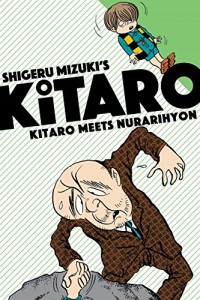
“If you are a lover of the weird or irreverent comedy mixed with supernatural horror, manga, and Japanese folklore-inspired fiction, then find the spiritual world portal of your choice to get your hands on a copy of Kitaro Meets Nurarihyon.” (Drawn and Quarterly)
By Julio Perez Jr. (Kyoto-shi, 2011-13) for JQ magazine. A bibliophile, writer, translator, and graduate from Columbia University, Julio currently keeps the lights on by working at JTB USA while writing freelance in New York. Follow his enthusiasm for Japan, literature, and comic books on his blog and Twitter @brittlejules.
Imagine coming home to find a stranger in your house. He acts like he owns the place, eats your food and drinks your beer, before leaving you reeling in confusion! Better send a letter to the Yokai Post for help from Kitaro, a charming character made by manga legend Shigeru Mizuki. Kitaro investigates strange phenomena and protects humans from ill-intentioned yokai.
Shigeru Mizuki’s Kitaro – Kitaro Meets Nurarihyon is a manga volume collecting seven more of Kitaro’s paranormal adventures. While this book can be enjoyed as a stand-alone dive into the classic character’s adventures, your enjoyment can be enhanced by checking out Kitaro’s origin story featured in the first volume, The Birth of Kitaro, reviewed last year by JQ here. This book is one of several entries in a list of literary delights from Japan that Drawn and Quarterly has been bringing to America for affordable access. This volume was also translated by JET Alum and Shigeru Mizuki expert/JQ interviewee Zack Davisson (Nara-ken, 2001-04; Osaka-shi, 2004-06).
Like it says on the tin, in this book Kitaro encounters a uniquely urban yokai: Nurarihyon. This creature takes on the appearance of an unsettling-looking and self-important man to stealthily wreak havoc as mundane as forcing you to serve him your best snacks and as extreme as explosions in cities.
Many of the yokai Kitaro encounters cause trouble because it is in their nature, some have a need to feed, or have a human-like impulse that persists beyond the grave, but Nurarihyon is cut from a different cloth. He is simply cruel and makes mischief because of his hatred for humans. He also stands apart from others in Kitaro’s rogues gallery because he finds it repulsive that Kitaro helps humans and targets him for that reason. You’ll have to pick up the book to find out just how Nurarihyon plots Kitaro’s demise, and how he very nearly gets away with it!
JQ Magazine: Book Review — ‘Womansword’
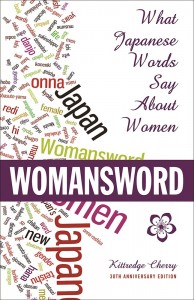
“Even if Womansword is an unintended trip back to the ’80s, it is a fascinating read and a striking reminder of how language can reflect the general mindset and culture of society.” (Stone Bridge Press)
By Rashaad Jorden (Yamagata-ken, 2008-10) for JQ magazine. A former head of the JETAA Philadelphia Sub-Chapter, Rashaad is a graduate of Leeds Beckett University with a master’s degree in responsible tourism management. For more on his life abroad and enthusiasm for taiko drumming, visit his blog at www.gettingpounded.wordpress.com.
Sometimes, I might come across a book that makes me feel as if I don’t know anything about Japan. Not that I didn’t learn a lot about the country during my JET days, but that the book contains so much information, it puts to shame what I’ve learned about Japan.
Such is the feeling I experienced while reading Womansword: What Japanese Words Say About Women. First published in 1987, the book examines Japan through the language used to describe women and the terms frequently employed by women. This new 30th anniversary edition of Kittredge Cherry’s work seems to be the perfect setting to learn about women’s issues I had never thought of.
And it certainly was, although I got a feeling from the book that I once experienced while observing the fashion sense of people attending a flea market in Yoyogi Park: everything is stuck in the ’80s. (More on that later.)
Womansword is divided into seven chapters that address themes such as motherhood, sexuality and aging. It provides relevant information before reaching the first chapter as the “Preface to the 30th Anniversary Edition” includes several details on how the landscape for women in Japan has changed—and hasn’t changed. The good news: In 1991, for the first time in history, more than half of Japanese women had entered the workforce. And in 2015, Prime Minister Shinzo Abe announced several measures to reverse the country’s shrinking birth rate as part of his Abenomics economic plan. On the other hand, Japan ranked 105th out of 136 countries in the 2014 Global Gender Gap Report and in the following year—more than 30 years after the Equal Employment Law was passed—Japanese women still earned lower pay and fewer promotions on average.
JQ Magazine: Book Review — ‘I Want That Love’
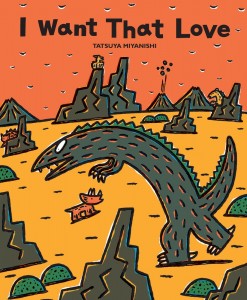
“I Want That Love is a very enjoyable read that teaches the importance of friendship, love and tenderness. Young readers will also learn how life’s most important lessons can be passed down from generation to generation.” (Museyon)
By Rashaad Jorden (Yamagata-ken, 2008-10) for JQ magazine. A former head of the JETAA Philadelphia Sub-Chapter, Rashaad is a graduate of Leeds Beckett University with a master’s degree in responsible tourism management. For more on his life abroad and enthusiasm for taiko drumming, visit his blog at www.gettingpounded.wordpress.com.
During your elementary school days, you surely read about the primordial creatures you know as dinosaurs. But if you haven’t been reminded of the creatures that roamed the earth roughly 65 million years ago in some time, you might not realize that there’s more than meets the eye. Case in point: Tatsuya Miyanishi’s I Want That Love.
I Want That Love (the third book in Miyanishi’s Tyrannosaurus series of 13 titles that have sold more than three million copies internationally) tells the story of a Tyrannosaurus, who is described by the author as “the strongest of all the dinosaurs.” Not surprisingly, everyone is scared of him as he never fails at getting his way by force. But the good times don’t last—the Tyrannosaurus (whose name is revealed to be Mr. Rhadbodon)—is somehow sapped of his strength after being bitten in his tail by a Masiakasaurus.
As expected from someone whose identity is clearly tied to brute force, the Tyrannosaurus loses all sense of who he is, so he’s desperate to find any solution to the disaster that has befallen him. Fortunately, he receives help in the form of berries given to him by fellow creatures and he uses his newfound energy to protect his friends from other dinosaurs.
JQ Magazine: Book Review — ‘Are You an Echo?’
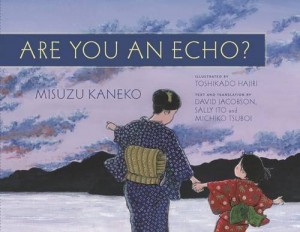
“This is an outstanding collection of poems that reflects a wide variety of emotions and observations while giving readers new and colorful images of Japan.” (Chin Music Press)
By Rashaad Jorden (Yamagata-ken, 2008-10) for JQ magazine. A former head of the JETAA Philadelphia Sub-Chapter, Rashaad is a graduate of Leeds Beckett University with a master’s degree in responsible tourism management. For more on his life abroad and enthusiasm for taiko drumming, visit his blog at www.gettingpounded.wordpress.com.
As we might take for granted the ability to research anything and everything quickly, it’s easy to forget how much of a struggle it has been (and still might be) to discover fascinating aspects of history. But when those discoveries are made, it’s satisfying not just for those who make the extensive effort—it’s rewarding for those who have benefited from the discoveries.
Thanks to fellow author Setsuo Yazaki, English-language speakers from all over the world now have the opportunity to read Are You an Echo? The Last Poetry of Misuzu Kaneko, a collection of poems produced by the late lauded children’s writer. Yazaki was a young student when he read Misuzu’s poem “Big Catch,” and he was automatically intrigued by her. So he wanted to discover more of her works and immediately started trying to find them—only to run into run one obstacle after another. Finally, Setsuo made a breakthrough when he was able to reach Misuzu’s younger brother Masasuke (then 77 years of age), who handed Yazaki a set of diaries, which included poems Misuzu wrote.
A prolific writer, Misuzu’s works regularly appeared in popular magazines. She wrote 512 poems, but only a few of them appear in Are You an Echo? Even so, that small sample size is enough to give you a glimpse into her life. Misuzu grew up in a fishing village in western Japan, and she loved being around water (she wrote one poem about an island she visualized but couldn’t reach). She also had a very vibrant imagination, and everything she encountered had feelings, like snowflakes (she’s actually concerned about their well-being) or telephone poles (which at one point, got sleepy). Even cicadas wore clothes in Misuzu’s world.






